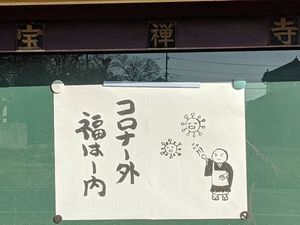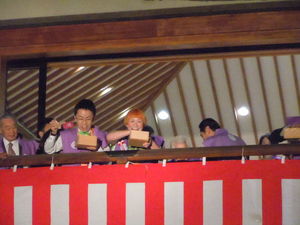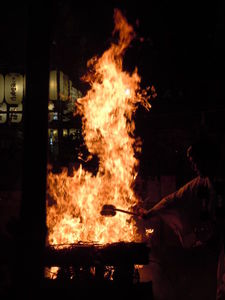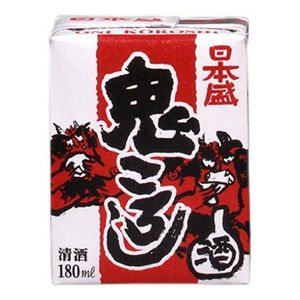I Miss You, Setsubun
By Sifton Tracey Anipare
ひさびさ ("it's been ages"), Open Book reader! Thanks for stopping by for another post. I hope things are going well for you these days. On my end, life has been wack. And yes, I'm aware of how old that word is...I don't know really know current slang words to accurately describe this past week...except maybe "cringe"? (Haha, no seriously, I don't know T__T) And naturally the pandemic isn't helping, nor is the imminence of Valentine's Day (more complaints to come about that), so to mitigate a lot of strong feelings, I've been going through old photos and reminiscing about one of my favourite festivals that happens every February in Japan. Of course, if you've read Yume, you'll know where this is going.
That's right. I'm talking about Setsubun today.
(“Korona— soto, fuku wa uchi”... yeah I’m losing patience with this pandemic too, Mr. Monk T__T)
With a few exceptions over the past few centuries, Setsubun falls on February 3. I want to say I didn't know much about Setsubun until my second year on the JET Programme. I'm sure I'd at least heard the name and gotten the gist of it involving demon masks and throwing beans during my eikaiwa (English conversation school) experience, but that would have been the extent of it. It was definitely after starting Yume that I became interested in attending a Setsubun event at some point. But that point came maybe three months after laying down the first four or five chapters. I had no idea how significant it would end up becoming until years later, since the very first draft had nothing to do with demons. (Ah, creative writing. Such fascinate, many interesting...wow ^__^”) Anyhow, Setsubun easily became my third favourite time of year in Japan - the cherry blossom season, a.k.a. 花見時 (hanamidoki) and autumn foliage season, a.k.a. 紅葉 (kouyou or momoji) are always neck and neck for the top spot - and essentially involves eating special sushi and throwing beans at people in costumes and masks to bid farewell to bad vibes and usher in good ones for the new year. In Yume you’ll see it’s pretty…significant. (ಠ◡ಠ)
The literal translation of Setsubun, or 節分 is “seasonal division,” as in a part or division of seasons, so there are four in a year but the one on February 3 refers to Risshun (立春), the end of winter and arrival of spring, and is considered the most important “Setsubun”. It’s believed to have been introduced to Japan about 1400 years ago from China. Lots of things are involved in the celebration, but the biggest are ehoumaki, a special kind of sushi if you're in the Kansai region, and most importantly, the ever-important scattering of beans, also known as mamemaki.
I have a confession: I've never tried ehoumaki. (I know, I'm ashamed.) But it's basically like uncut futomaki, which is a super-thick roll of sushi that usually comes with egg and vegetables and it's my go-to favourite of all sushi, so I'm confident I'll love it whenever I get the chance. Ehoumaki is only eaten on Setsubun, so it's not something you can find year-round. I also learned later that it's a regional thing, so if you're in Japan in February, the Kobe-Osaka-Kyoto area is where you want to be. Mamemaki, however, happens everywhere. Like garlic for vampires or salt for faeries, beans were believed to have sacred power against oni (demons/evil spirits responsible for causing disease, disaster, and bad luck in general). On Setsubun, roasted soybeans are scattered around the house to ward off any evil spirits lurking around, gearing up to ruin your year. Mamemaki also take place in elementary schools. As we throw our beans around the room or pelt them at a designated “volunteer” wearing a demon mask or costume, we chant “oni wa soto, fuku wa uchi” (“demons out, [good] fortune in”), then count out a number of beans the same as our age plus one, as an extra bonus to guarantee a positive and healthy year. If you attend a celebration at a shrine, your beans will come in cute little packages hurled into crowds by the shrine workers or sometimes even celebrities.
On my first Setsubun night in Japan I didn't know where to get ehoumaki and eat it before meeting my friend Izumi in Osaka. I knew supermarkets had it, but eating in public wasn't really a thing (at least back then), so I opted to go to my favourite kaitenzushi (conveyor-belt sushi) place in Umeda, called Ganko. Ehoumaki is meant to be eaten whole, facing the direction believed to bring good fortune for that particular year. I had several plates of futomaki that night, and although I can’t say which way I was facing, I’m pretty sure it was the wrong way for a hot minute because a waitress had to move me to a safer seat (it’s fine, it gave me the inspiration for the most exciting part of Yume's Chapter 8!). The rest of my first Setsubun night was awesome, though. A number of celebrities were at the shrine throwing soybean packs into the crowds while someone chanted over a loudspeaker, and despite the cold we were warmed by all the pyres around the shrine grounds.
Your CanLit News
Subscribe to Open Book’s newsletter to get local book events, literary content, writing tips, and more in your inbox
The air smelled of burning cedar and all the food cooking at nearby stands. We caught many packs of soybeans, but I ended up with several more after a long conversation with a curious obaachan who gave me all the beans she'd fought for (shout-out to you in Chapter 17, obaasama!). Izumi gave me a bunch of hers, too. I think I finished the last of them all sometime in March. Let's just say I had a very prosperous year. ^__^" And while I would go on to attend many more events and festivals over the next few years of living there (and several more when I went back to visit), that first Setsubun really stuck with me. I don't know if it was the general festival atmosphere, or the idea of what Setsubun represents, or the feeling I had while walking around in near-darkness of constantly being watched while people were ready to defend themselves against potential oni hiding in the shadows, or maybe even in plain sight. Maybe it was a combination of everything. All I know is it all went into a really long, really weird book that I am quite proud of and that people seemed to enjoy. Hopefully when コロナー ("the Rona") takes a hike I can attend another festival that is half as inspiring. (I mean, it'd be a big help, because Yume 2.0 can always benefit from a creativity boost.) Until that time, let's raise a toast to Setsubun and any oni that survived it. Kanpai ("cheers")!
(Yes, this is the infamous "Oni Koroshi" sake box. I would describe it as an acquired taste...one I still get just looking at this picture. If you know, you know.)
Bonus: here’s a SoyJoy commercial from 2016 I discovered while writing this post. It's called “Smart Setsubun”. It levelled up my life. May it do the same for you.
The views expressed in the Writer-in-Residence blogs are those held by the authors and do not necessarily reflect the views of Open Book.
Sifton Tracey Anipare is a Ghanaian Canadian writer who lived and taught in Japan for four years. She loves video games, bubble tea, and Japanese coffee mixes, and is an avid collector of stickers and stamps. Yume is her first novel.







